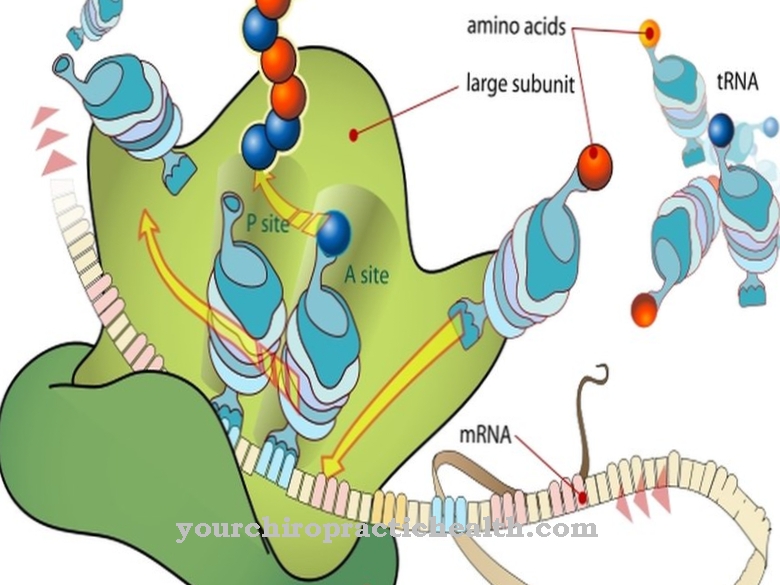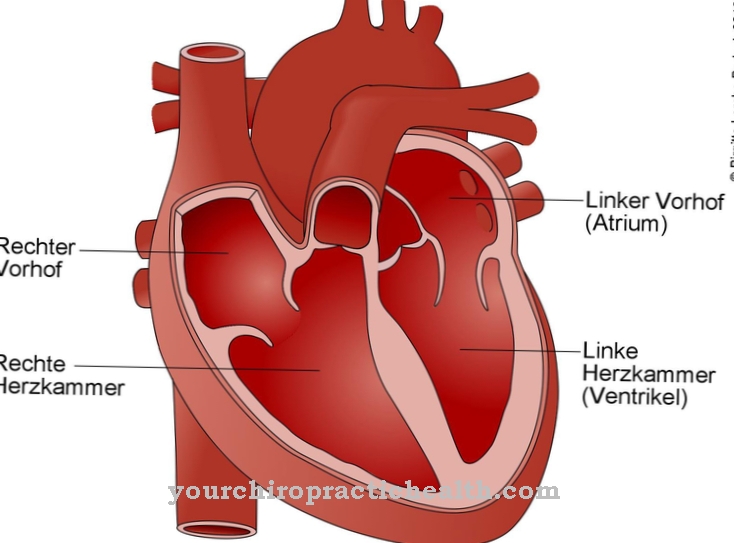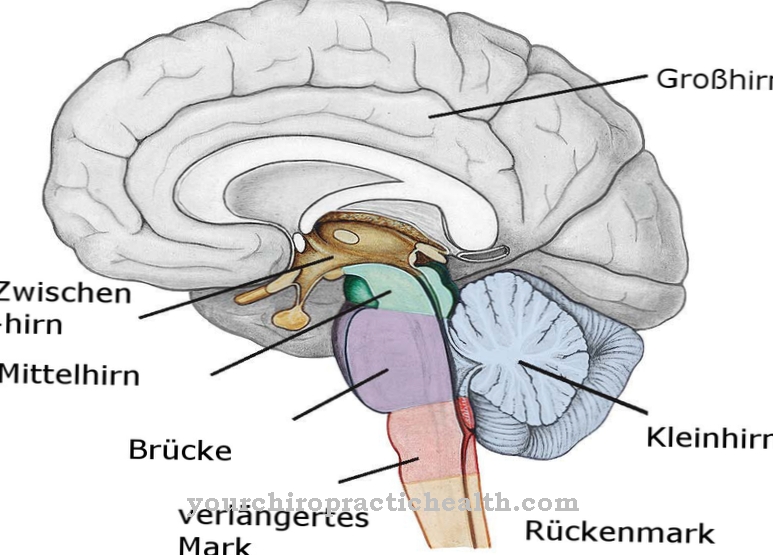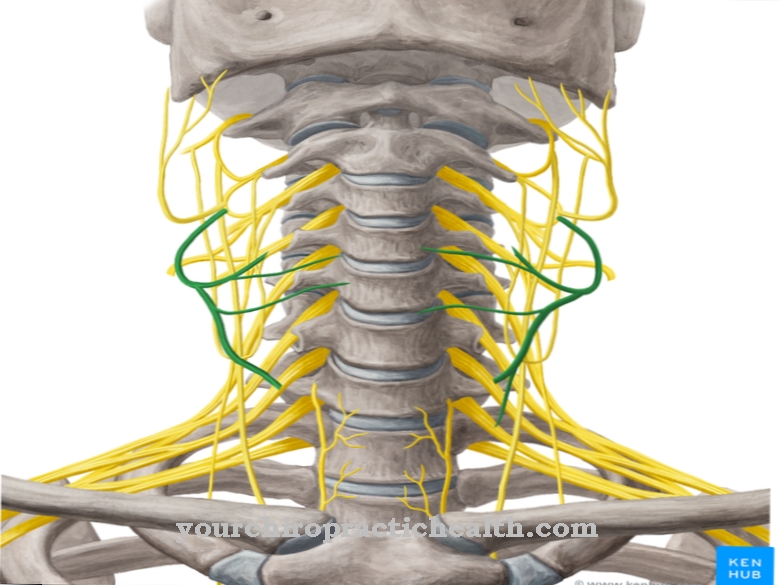The Frontal sinus belongs to the sinuses. It lies under the forehead bone, at the level of the eyebrows or a little above. The frontal sinus is lined with mucous membrane and has the function of ventilating the respiratory system as well as warming, humidifying and cleaning the breathing air.
What characterizes the frontal sinus?
The Frontal sinus (Frontal sinus) is a bony cavity in the skull that forms in the frontal bone (Frontal bone) is located above the bridge of the nose. Their inside is covered with mucous membrane. The frontal sinus occurs in pairs and belongs to the paranasal sinuses, which are connected to the nasal cavity. It is part of the breathing apparatus.Since it is very variable in shape and size and is created individually for each person, it is also known as the fingerprint of the skull. The frontal sinus is not present at birth, it only develops later. The period of strongest growth is from the eruption of the permanent teeth until the end of puberty. Only when the body has grown in size has the frontal sinus reached its final dimensions.
Anatomy & structure
The two frontal sinuses in the skull bone are cavities filled with air. That is why they are also called pneumatization rooms (from the old Greek pneuma = air). They are completely lined with mucous membrane, the respiratory ciliated epithelium. This consists, among other things, of mucus-producing goblet cells and kinocilia. The latter distribute the mucus with shimmering movements towards the throat.
In addition to the connection between the frontal sinus and the other paranasal sinuses, there is also a channel to the nasal cavity, the sinus duct. The size of the frontal sinus varies from person to person, and the shape is not always the same. For Europeans, for example, a distinction is made between four different forms. The mitral shape is the most common variant, while the bean shape is rather rare. The leaf shape and the pyramid shape are roughly in between in terms of frequency.
The frontal sinus is usually asymmetrical and its two parts are defined by the Interfrontal septum separated, a cartilaginous septum that is not in the middle in most people. The frontal sinus is bounded by the roof of the eye socket and by the anterior cranial fossa, a depression in the base of the skull.Function & tasks
The evolutionary development of the paranasal sinuses, including the frontal sinus, is attributed to the fact that the skull bone can reach an appropriate size without being burdened by excessive weight.
Originally it was assumed that the sinuses are involved in voice formation by serving as resonance cavities. However, various experiments showed that this assumption was wrong. Important tasks of the frontal sinus are humidification, warming and cleaning of the breathable air. When you inhale, the air flows through the frontal sinus and the other sinuses.
This allows microscopic foreign bodies and microorganisms to penetrate. The ciliated epithelium, with which the frontal sinus is lined, consists of various glands and cells. The so-called goblet cells are glands that are responsible for the formation of mucus and are located between the other cells of the ciliated epithelium.
Under the microscope you can see that this mucous membrane looks like a lawn with constantly moving - flickering - blades of grass. The goblet cells continuously produce mucus and release it to the surface. The cinema cilia ensure that this mucus is transported further. This removes foreign bodies and microorganisms from the airways.
They are pushed towards the throat with the mucus and can then drain away. This self-cleaning mechanism of the ciliated epithelium is called Mucociliary Clearance (MCC). In addition to cleaning the air we breathe, the frontal sinus is used for heating and humidification. As the air blows through the sinuses, its temperature is warmed to that of the body.
This is why it is so important to breathe through your nose when it is cold outside so that air that is too cold does not get into your lungs. Another task is humidification. The constant release of mucus in the frontal sinus increases the humidity. If the breath is too dry, it irritates the mucous membranes and can lead to infections.
You can find your medication here
➔ Medicines for headaches and migrainesIllnesses & ailments
The most common disease of the frontal sinus is Frontal sinusitiswho have favourited frontal sinusitis. It occurs in both acute and chronic forms. Often, not only the frontal sinus is affected by the inflammation, but also other sinuses.
Acute sinusitis usually occurs as a result of a cold. The inflammation of the mucous membranes of the nasal cavity spreads to the frontal sinus or other sinuses. The mucous membrane swells and can no longer fulfill its task of humidifying, warming and cleaning the air we breathe. Mucus and, in the case of bacterial inflammation, also pus (frontal sinus empyema) collects.
As a result, the frontal sinus is blocked and the mucus can no longer drain away. The build-up creates pressure that manifests itself in a headache. A good way to tell whether the frontal sinus is inflamed is a pressing headache when the upper body is bent down.
By lowering the head, the pressure on the frontal sinuses is increased, which in the case of inflammation causes throbbing pain in the forehead area. In chronic sinusitis, the inflammation recurs and does not heal, while the acute form only occurs for a short time.
In some people, the frontal sinus does not develop adequately ("frontal sinus hypoplasia"), which leads to more frequent inflammation. Injuries caused by excessive force in the forehead area can break the frontal bone. If the back wall of the frontal sinus also breaks, inflammation of the brain structures is possible.












.jpg)



.jpg)










.jpg)
